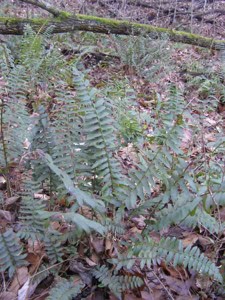Christmas Ferns
Originally published December 23, 2008

Photo by Ken Moore. A robust Christmas fern stands out on a forest-floor sea of Christmas ferns.
By Ken Moore
Christmas fern, Polystichum acrostichoides, is common in forests throughout the eastern United States and especially in our local piney and mixed deciduous woods. The dark evergreen-green fronds (leaves) of this fern stand out on the brown forest floor of the winter woods.
I’ve heard several creative notions behind the common name, but none relate to the religious heritage of this time of year. I have read that these evergreen fronds were used for indoor decoration during the Christmas season. I’ve never seen them used in this way, but I can imagine them spread across fireplace mantels in years gone by.
Looking intently at a single dark-green leaf of this fern during a rainy woods walk this past Saturday, 6-year-old Gabe immediately exclaimed that the leaf looked like a Christmas tree; and, indeed, it does.
There are creative Christmas-season descriptions of a single pinna (a leaf segment) of the fern leaf. To some imaginative minds, a single segment represents a Christmas stocking or Santa’s boot. To picture this, take an individual leaf segment and hold it vertically with the long pointed side up and the short point of a boot or stocking projecting to one side at the bottom.
And just this week, someone described to me that in holding that leaf segment horizontally you can imagine Santa’s pointed head sitting at the back of a really long sleigh.
As a woodland plant or a garden plant, the Christmas fern is handsome year-round except for a brief period in the late winter when the leaves may be flattened to the ground by the odd winter snow or two. The fuzzy fiddleheads of the new fronds begin uncurling upward in early spring. Be advised that these are not the tasty-to-some edible fiddleheads of the common ostrich fern found much farther north.
Christmas ferns are easily cultivated, and once established will survive periods of drought, though I always like to add a little extra rain-barrel water to mine during really hot, dry periods. Single clumps with both horizontal-inclined leaves and stiffly erect leaves, up to a foot and a half tall, make great accent plants in shady landscapes. One local gardening friend has created a forest floor-like ground cover with dozens of these ferns rescued a few years ago from a local residential construction site.
When you come upon a clump or two of Christmas ferns in the forest, you may assume that in that spot there is a little more moisture in the soil. Whenever I discover an extensive carpet of these ferns on a forest floor, I have an urge to simply settle down in the middle and enjoy floating on a sea of dark green. You may consider trying it sometime when no one is observing.


Comments are closed.